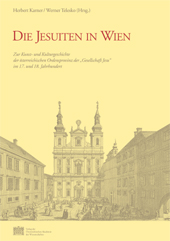


Der Band „Die Jesuiten in Wien“ untersucht wesentliche historische und kunsthistorische Aspekte des Wirkens der „Gesellschaft Jesu“ in Wien als Zentrum der österreichischen Ordensprovinz im 17. und 18. Jahrhundert. Die Jesuiten, die 1551 nach Wien kamen, entfalteten in der Folge eine rege missionarische und kulturelle Tätigkeit. Darüber hinaus war die „Gesellschaft Jesu“ durch die enge Bindung an das Kaiserhaus ein eminent politischer Faktor im Rahmen der vom Haus Habsburg nachhaltig geförderten Gegenreformation. Bis zur Auflösung des Ordens im Jahr 1773 dominierte der Orden das höhere Bildungswesen und hatte durch eine umfassende Predigttätigkeit wesentlichen Einfluss auf das geistige Klima der Zeit. Die Beschäftigung mit der „Gesellschaft Jesu“ ist von hohem interdisziplinärem Interesse, da sich ihre Leistungen auf viele unterschiedliche Gebiete, wie etwa das Theater, die Naturwissenschaften, die Philosophie, die bildende Kunst, die Architektur und die Pädagogik erstreckten. Die Bedeutung des Jesuitenordens kann auch in territorialer Hinsicht abgelesen werden. So war Wien der Sitz der österreichischen Ordensprovinz, die zum Zeitpunkt der Aufhebung des Ordens 1773 Ober- und Niederösterreich, Steiermark, Kärnten, Krain, Kroatien und Slawonien, Ungarn mit der Slowakei und Siebenbürgen umfasste.
Gedruckt mit Unterstützung des Fonds zur Förderung der wissenschaftlichen Forschung (FWF).

…
The Jesuits in Vienna” attempts to investigate salient aspects of the contributions of the Society of Jesus in terms of history and art history in the 17th and 18th century, a period when Vienna was the undisputed centre of the order’s Austrian chapter. The Jesuits had first arrived in Vienna in 1551 and were soon active in promoting missionary and cultural activities. Owing to its close connections with the Imperial House, the Society of Jesus assumed an eminently political role in the Hapsburg dynasty’s long and persistent efforts to enforce the Counter-Reformation. By the time the order was dissolved in 1773 it had achieved a dominant position in the field of higher education and, through its extensive preaching and missionary activities, exerted a major influence on the intellectual spirit of the times. This justifies the heightened interest across the academic divides in the Society of Jesus, since the Jesuits left their mark in a wide variety of fields including theatre, the natural sciences, philosophy, the visual arts, architecture and teaching theory and practice. In addition, the significance of the Jesuit order can also be gauged from a territorial perspective. In this sense, Vienna was at the centre of the order’s Austrian chapter, which at the time of its dissolution in 1773 comprised Upper and Lower Austria, Styria, Carinthia, the Slovenian Krajnsko, Croatia, Slavonia, Hungary as well as Slovakia and Transsylvania.
2003,
978-3-7001-3203-5
978-3-7001-3355-1
282 S. Text u. Bildteil + 16 S. mit Tafeln
, 29,7x21cm, broschiert, Veröffentlichungen der Kommission für Kunstgeschichte 5